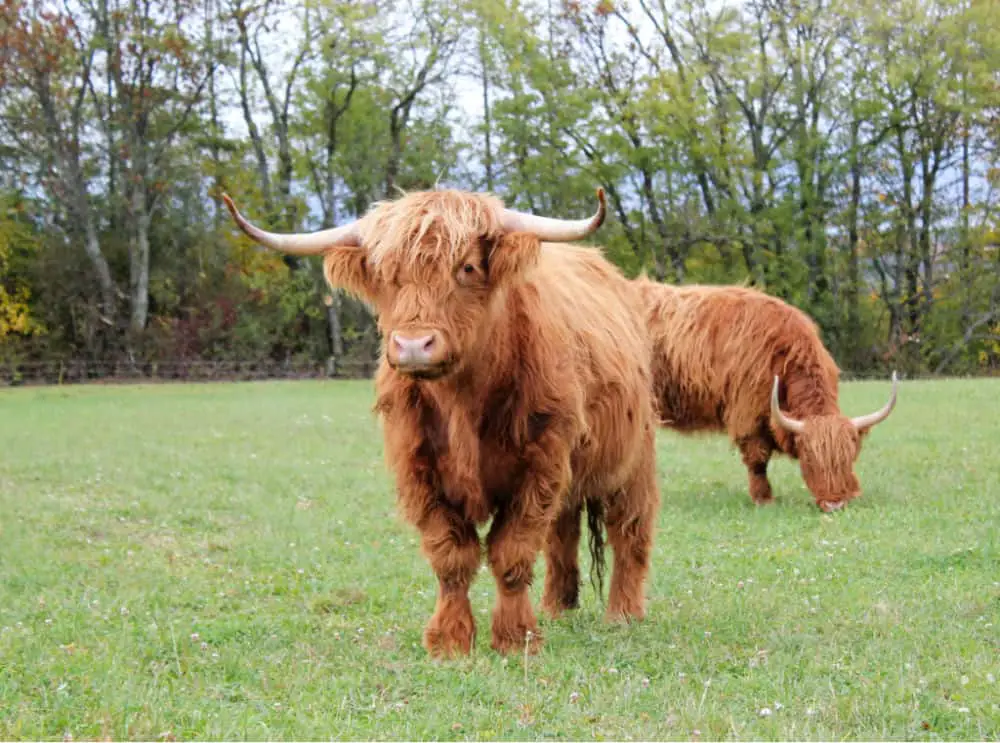
An ancient breed surviving for centuries in the Highlands and Islands of Scotland they create a great deal of curiosity and a multitude of questions. Highland Cattle can live for 15 to 22 years.

Bò Gàidhealach gälisches Rind ist eine Rasse des Hausrindes.
Scottish highland cattle lifespan. What is an interesting fact about Highland Cattle. Highland Cattle are natively found in the Scottish Highlands. What is the scientific name for the Highland Cattle.
The scientific name for the Highland Cattle is Bos Taurus. What is the lifespan of a Highland Cattle. Highland Cattle can live for 15 to 22 years.
How fast is a Highland Cattle. Highland cattle live within a hierarchy system where individuals are ranked depending on age and sex. Older ones dominate younger ones and males dominate females.
In addition young males begin to dominate adult females reaching the age of approximately 2 years. Das Schottische Hochlandrind Highland Cattle oder Kyloe schott-gäl. Bò Gàidhealach gälisches Rind ist eine Rasse des Hausrindes.
Highland cattle do not need such fat for protection. And it has been noticed that Highlands do not increase their feed intake until the temperature drops to -18 degrees F while other breeds increase their intake at 32 degrees F. That is why the meat of Highland cattle tends to be leaner than most beef.
The Scottish Highland cows are a bit smaller than the bulls but they are still large. They weigh an average of 1100 pounds when fully matured. Raising Scottish Highland Bulls and Cows.
Like any other animals you want to raise you should understand the needs of this cattle breed. Luckily there are only a few requirements for them to thrive. Highland Cattle Meat.
Breeding for meat is why a lot of farmers keep the Hairy Coos. Their meat is lean but well marbled normally rated as premium beef. Pure Highland beef comes at a price pure Highland beef commands a premium price due to.
Scottish Highland cattle have lived for centuries in the rugged remote Scottish highlands. The extremely harsh conditions created a process of natural selection where only the fittest and most adaptable survivedThey are one of the oldest registered breeds of cattle with the first herd book established in Scotland in 1884. Highland cattle breed is thought to live longer and produce more calves than most other cattle breeds.
They are native to the areas in Scotland that are close to the Arctic circle and thus have adapted to the harsh climates and environments that occur that close to the Arctic. Scottish Highland Cattle with their magnificent horns long wavy coats and gorgeous fringes attract attention like no other cattle. An ancient breed surviving for centuries in the Highlands and Islands of Scotland they create a great deal of curiosity and a multitude of questions.
Highland cow may be descended from the ancient aurochs. SCOTLANDS iconic Highland Cattle may be partly descended from wild oxen known as aurochs that roamed these islands thousands of years ago and have long been extinct. Scientists in Dublin have successfully extracted genetic material from an aurochs bone discovered in a cave in Derbyshire.
Cattle Handling Tips For Highland Owners Highland cattle are known among other things for their calm nature and easy going disposition. That being said there are some techniques and rules of thumb that a person will learn as they go through the years with their own herd of cattle. Highland cattles ability to adapt to the cruel climate of the Scottish Highlands might have contributed to their impressive longevity.
They live an average of 15 to 22 years substantially longer than most other members of the bovine family. Long-haired highland cattle. Scottish north highland cattle.
Up to 800 kg. Up to 500 kg. 20 years higher than most of Scottish cattle.
Highland cattle come in a variety of different colours the red yellow white black dun silver and brindle. The genetics controlling the colour of highland cattle is complex. The dominant colour is black but over the years the cattle have been selectively bred to produce mainly red cattle.
Their coat is made up of 2 types of hair. Calved bull calf 7-15-20. Exposed to Coors for 2021.
Born January 17 2014. Red dehorned mini highland cow. Calved a bull calf on 9-25-17.
Calved a bull calf on 12-8-18. Calved a red heifer calf 6-22-20. Exposed to Loki for Spring 2021.
T his shaggy-haired long-horned animal is closely associated with the beauty mystery and romance of the Scottish Highlands. Underneath this dramatic appearance lies a useful and productive cattle breed. The Highland descends from the native cattle of Scotland.
The breed was improved and standardized during the 1800s. Scottish Highland Cattle typically weigh 1000 - 1800 pounds when fully-grown. They are most easily recognizable by their long shaggy double coat.
Their outer hair may grow to 13 inches long and it is well-oiled to shed precipitation. This oil helps the Highlands to be less affected by the snow and rain by reducing the amount that is able to. Scottish Highland Cattle are ideally suited for life in Oregons Willamette Valley - a harsh climate they enjoy living in.
With mild wet winters followed by comfortable summers pastures and forests can sustain these varied grazers throughout the year on a natural diet.